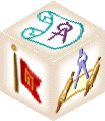systematic and open-ended creation |
| The Zone of Emergence Model is at the core of the Taylor Method. It has many dimensions each distinct - and all have to be integrated as a system. It is about setting up the conditions necessary for creativity, systematic, open-ended emergence and GroupGenius to happen - not by accident, by focused human effort. |
| I call these conditions the Boundary-Rules. “Rules” in terms of rule-based systems. “Boundary” in terms of the physical and mental - including rules-of-engagement - environment of a single person, team, group, organization, society that establishes the frame of their interaction in a work relationship, event or project. |
| The first step of the process is to bring an agent into an environment of agents. This is a sentence loaded with meaning and nuance. In terms of Miller’s Living Systems model, every boundary has specific properties. Some things can cross it and some cannot. In term of accomplishing v=V, those things that stay out attenuate variety, those that come in, augment the variety of the exercise. The environment is carefully designed. The selections of individuals and objects and agreements which bring a human agent within a specifically created environment are acts of design. These moves will have profound effects on the outcome of the “game” to be played within the “created” environment. All other things being equal within, the selection of participants - and the rules of engagement that constitute the agreement of their participation - make up an inordinately great influence on the outcome. |
| In our society, these rules-of-engagement are not easy to negotiate and to practice. People do not like to have what they perceive as their freedom truncated. They, rarely, know what conditions support creativity let alone group creativity. So, they impose their individual proclivities - the sum of which, with may participants - add up to a soup that defeats creative emergence so effectively it is difficult to imagine how to design a process that could be more successful in doing so. Of course, these processes are “designed,” by habit, default, organizational politics and the exercise of power. The Jesuits used to say “given me the boy until he is six and I give you the man.” Give me the agenda and the venue and I give you the meeting result - to a point. The limit it this: it is the kind of interaction that is established and usually in our society today this is radically biased toward control and serving the agenda of those in power. In other words, meetings are usually managed to reduce risk as a few define it. |
| Despite the hype, most modern organizations do not want creativity - they want better results and they have learned that somehow “creativeness” is involved. They are generally opposed to allowing, promoting and establishing the conditions out-of-which creativity and GroupGenius can emerge. Creativity cannot be mandated or directly caused. It can be facilitated. the conditions necessary for it happening can be established. This is the goal of the Taylor Method. |
| The reason that MG Taylor first brought DesignShop® events and then the NavCenter® place to market is that they are relatively easy to establish - and keep the integrity in place - than attempting to introduce creativity and collaboration, in a general way, into cultures that are most likely going to kill these dangerous intrusions. People can much more readily accept that “if you go to this event for three days you engage this way,” or, “if you go into this space you do likewise” than they can accept the same rules in their everyday work environment. |
| There is widespread belief that these boundary conditions can be broken with impunity. In actuality, they cannot. It is interesting that the same people who would never impose arbitrary acts on an orchestra, a surgeon, a lawyer - or any professional - will do so when confronting one of the most complex systems we know of: a human mind interacting with many other human minds. It is as if “I have one (a mind) therefore I know how it works” Well, you have a car - do you know how it works and what it takes to produce one? This myth of knowing and the widespread willingness to impose , frankly, really stupid rules on the act of group creation is the primary reason for its lack in our society at a time when we need it the most. |
| In this article I will outline aspects of the zone of emergence phenomena, how and why it works and how it applies to the “easy” applications of the DesignShop and NavCenter. I will also indicate how and why PatchWorks™ is the next logical step in this practice [link: practice]. |
|
Matt Taylor
Triesen
October 28, 2006

SolutionBox
voice of this document:
ENGINEER • STRATEGY • CONSTRUCTION DOCUMENT
|
click on graphic for explanation of SolutionBox |
posted:
October 28, 2006
revised:
June 7, 2007
• 20061028.802321.mt • 20070607.989800.mt •
(note:
this document is about 5% finished)
Copyright© Matt
Taylor 1982, 1999, 2001, 2006, 2007 |
|
|